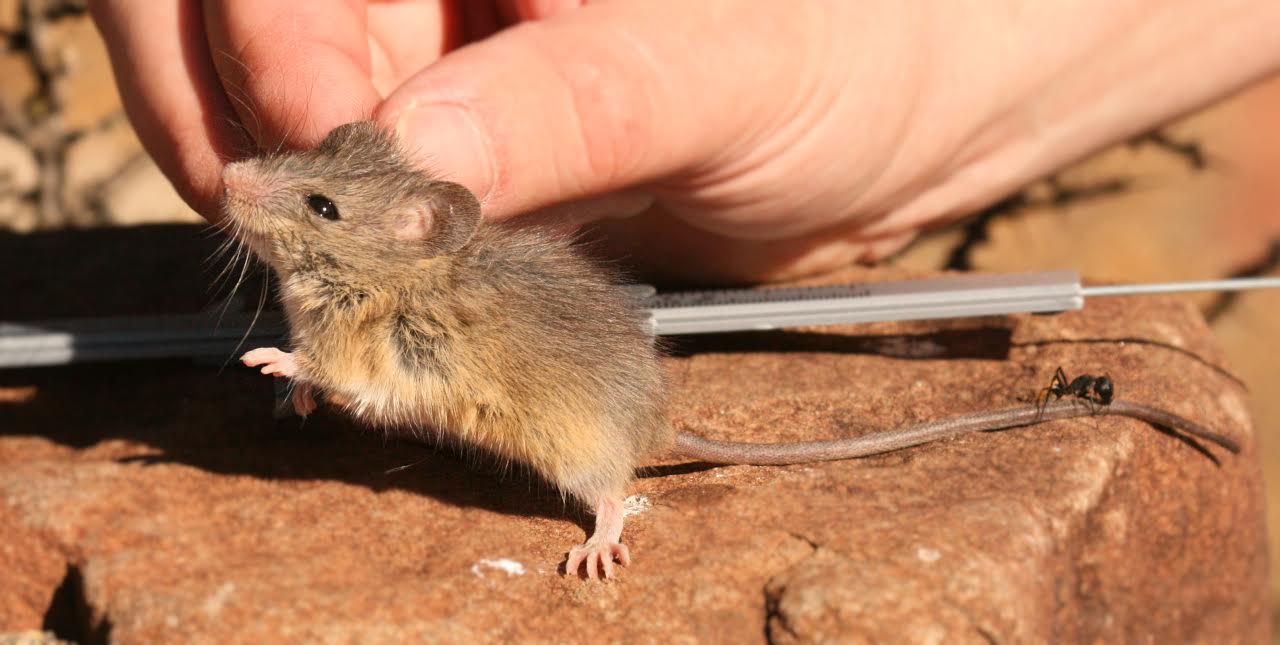Attention South African Rodent Experts: Mystery Mouse from South Africa
Mike Richardson asked me to post the following pic of an animal he is trying to ID. He says
“The mouse was captured in rocky habitat at Dunedin Farm near Beaufort West, Western Cape, South Africa. I captured many Namaqua Rock Mice (Micaelamys namaquensis), including juveniles, in the same area. However, this mouse was smaller with a proportionately shorter tail and larger ears. It had white feet and the fur colour closely resembles that of the Pygmy Rock Mouse (Petromyscus collinus) photographed in my field guide. The mouse had a head/body length of approximately 8cm. Tail was 9.5cm.
However, despite the above I still think it may be just another Namaqua Rock Mouse. For instance the face doesn’t look blunt enough for Pygmy. I’ve struggled to find reliable Pygmy RM photos on the internet. Any help or confirmation greatly appreciated.”

What do you think?
It looks to me like it may have lost the end of its tail which might explain why the head and tail proportions are a bit wrong for namquensis
I am going to Dunedin myself at the end of the month so maybe I can catch one too
Jon
4 Comments
-
Vladimir Dinets
Here’s a photo of P. barbouri. Note elongated ears and short, dense fir with no guard hairs: http://www.planet-mammiferes.org/drupal/en/node/40?indice2=Photos%2FRongeur%2FMyomo%2FAutMurid%2FPetrBar1.jpg
-
Mike Richardson
Thanks for the comments. Yes, the tail does look like it’s missing the end in the photo although I didn’t notice this at the time for some reason. On the day I trapped the mouse I had been up before dawn looking for the rabbits and by the time I returned to the traps it was already getting very hot. Worried about any other captives I didn’t spend much time taking measurements or photos of the mystery mouse, other than noting it appeared different to the other 20+ Namaqua Rock Mice I had already captured. I really need to learn to take more time taking measurements, photos etc. at the time.
Having said that the evidence seems to point to young Namaqua Rock Mouse anyway. Thanks again for the help.
Unfortunately other than a tonne of NRM the only other small mammal I captured was a Reddish-grey Musk Shrew. I think trapping further away from the farm buildings might have yielded a greater diversity of species although on this trip I wouldn’t have had time to check them until a couple of hours after sunrise, by which time it was already too hot for an exposed aluminium trap.
-
Vladimir Dinets
In cases like this it’s a good idea to take a tissue sample. All you need is a tiny vial and a pair of scissors; you snap a triangular piece about 2 mm wide off the edge of the ear and the animal usually doesn’t even flinch. When you trap small mammals, discovering a new species is always a possibility.
Leave a Reply
You must be logged in to post a comment.


Vladimir Dinets
The tail does look clipped on the photo. Were the ears only proportionally larger or also larger in absolute size? Juveniles of many species have proportionally larger ears. Here’s a photo of a juvenile Namaqua rock mouse showing proportionally larger ears than in adults: http://www.mammalogy.org/micaelamys-namaquensis-1101 However, its fur is more grayish than in typical adults or in the animal we are discussing.
I’ve seen animals I identified as P. collinus at Brandberg, and they had even longer ears, more elongated in shape, and longer faces. All Petromyscus have very soft, silky fur. There is a photo in Walker’s Mammals of The World 6th edition, and it shows an animal with white color reaching much higher on the flanks.
Vladimir